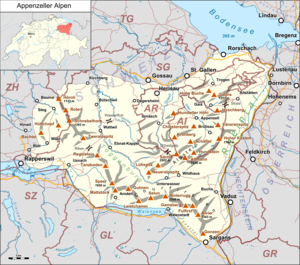Seealpsee (Appenzell Alps)
| Seealpsee | ||
|---|---|---|

|
||
| Seealpsee in the Alpstein area | ||
| Geographical location | Canton of Appenzell Innerrhoden | |
| Tributaries | Schwendebach | |
| Drain | Schwendebach | |
| Data | ||
| Coordinates | 748 412 / 237186 | |
|
|
||
| Altitude above sea level | 1141 m above sea level M. | |
| surface | 13.6 ha | |
| Maximum depth | 15 m | |
The Seealpsee is an at 1141 m above sea level. M. lying lake in the Alpstein region in Switzerland and belongs to the canton of Appenzell Innerrhoden . The idyllic location, the clean water and two mountain inns make the Seealpsee one of the most popular excursion destinations in the Alpstein region.
It is named after the neighboring Seealp . It was first mentioned in 1682 as See Alper See .
Red color
In July 2009 and 2010, according to studies by ETH Zurich and the Universities of Zurich and Copenhagen in 2009 , the Seealpsee turned red due to a high density of the alga Tovellia sanguinea , a dinoflagellate species. This thrives particularly well in nutrient-poor cold water lakes at altitudes above 1000 meters. This is the first appearance of red water discoloration by Tovellia sanguinea since the discoloration of Lake Tovel until 1964.
According to a communication dated July 14, 2010 from the Office for Environment and Water Protection in the canton of Appenzell Innerrhoden, this effect is due to the formation of a sediment saturated with oxygen . According to theory, the reason for its formation is the increasing purity of the lake due to the continuously decreasing nutrient load. To verify this thesis, professional divers from a team at the University of Konstanz took several analysis samples from the lake sediment. These samples are incubated in the laboratories of the University of Konstanz under oxygen and with the exclusion of oxygen. If it turns out that dinoflagellates develop better with oxygen supply, this would be a valuable result, since the red alga could be used as a bio-indicator for optimal water quality .
Approaches
The Seealpsee can be reached in about 60 minutes on foot from Wasserauen , the terminus of the Appenzeller Bahnen , on a partly steep, but mostly paved path. An unpaved, somewhat longer and somewhat less steep hiking trail leads from Wasserauen upwards over the southeastern side of the valley (Hüttentobel) to the Seealpsee. A very steep but beautiful path leads down from the Ebenalp through a prehistoric cave, past the Wildkirchli to the Gasthaus Aescher, which is built on the rock under a steep rockfall; the path continues down to the Seealpsee.
Others
The view over the Seealpsee towards Säntis is shown on bottles and cans of the Quöllfrisch beer .
gallery
Web links
- Spherical panorama of the Seealpsee on appenzellerlinks.ch
- Seealpsee in the Appenzellerland travel blog at littlecity.ch
- To the hiking tips around the Seealpsee Hiking tips around the Seealpsee from the travel blogger from reisememo.ch
Individual evidence
- ^ S. Sonderegger: The place and field names of the Land of Appenzell, Bd. I: 530, Frauenfeld 1958
- ↑ Tovellia sanguinea colored Seealpsee red ( memento of the original from August 13, 2013 in the Internet Archive ) Info: The archive link was inserted automatically and has not yet been checked. Please check the original and archive link according to the instructions and then remove this notice. Media release from the University of Zurich on August 20, 2009
- ↑ Renewed algae bloom in Seealpsee ( memento of the original from September 7, 2016 in the Internet Archive ) Info: The archive link was inserted automatically and has not yet been checked. Please check the original and archive link according to the instructions and then remove this notice. Office for the Environment, ai.ch of July 14, 2010, accessed on March 15, 2016





